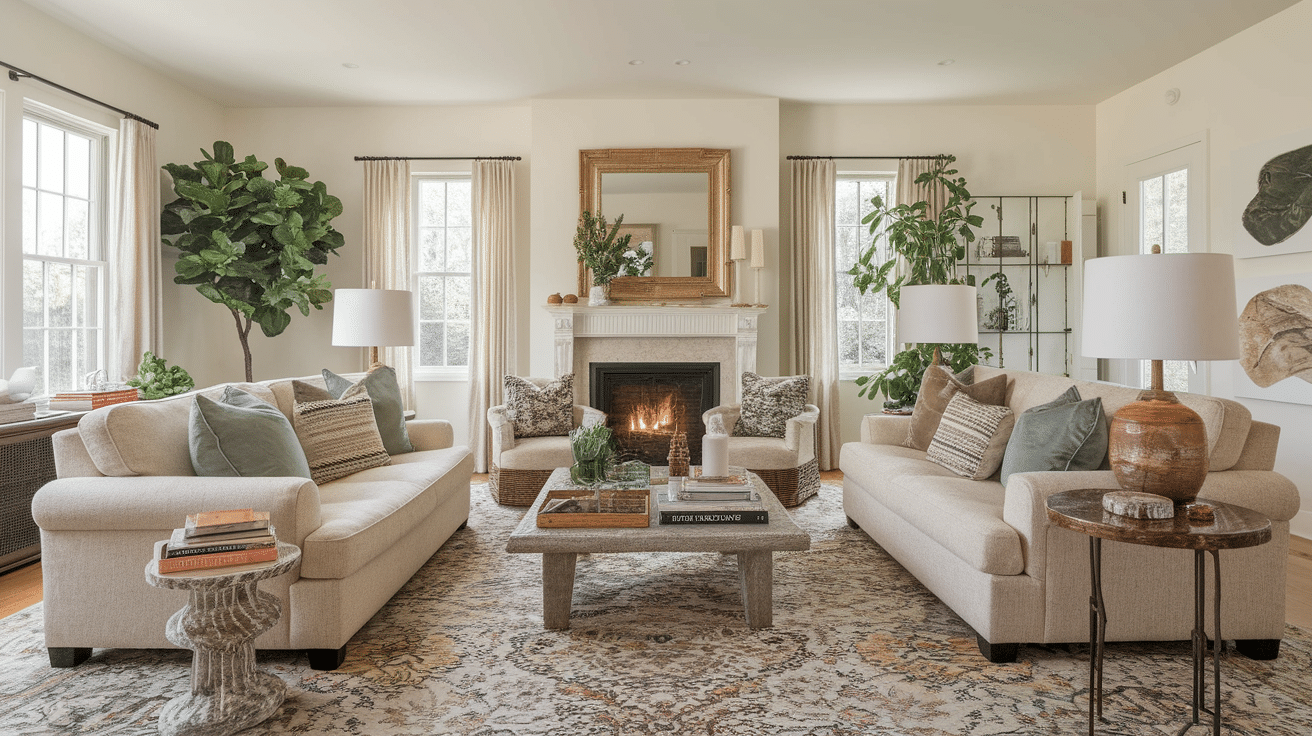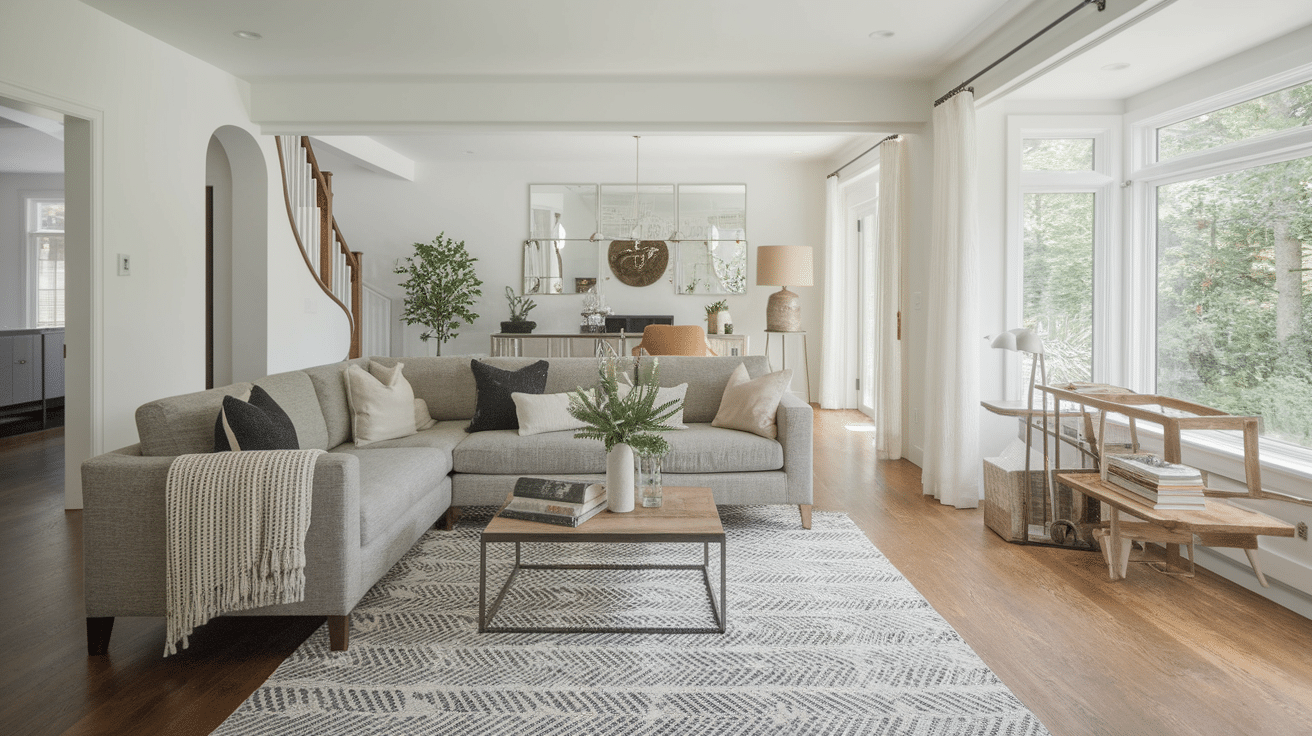Your living room isn’t just a space—it’s where comfort meets character.
I have spent years helping folks turn simple rooms into places they love to be. A good living room works hard for you. It’s a spot for family movie nights, quiet reading, and hosting friends.
I know how hard it can be to make a room feel just right. You want it to look good but also work for real life. That’s what makes a true dream living room—not fancy stuff from magazines, but a room that fits your needs.
In this blog, I’ll share five simple steps to help you build a living room you’ll love coming home to. These steps aren’t about spending lots of money. They’re about smart choices that add up to big results.
Why Your Living Room Matters?
Your living room is the heart of your home. It’s where you unwind after work, spend time with family, and welcome friends. A well-designed living room affects your daily mood.
This room tells visitors who you are through its colors, items, and layout. It serves many purposes, from movie nights to holiday gatherings. A good living room grows with you over the years.
Money spent on this space is well used since you’ll enjoy the results daily. Small changes can make big differences in how the room feels. The effort you put in now pays off for years to come.
5 Steps to Creating Your Dream Living Room
I’ll walk you through five simple steps to transform your living room. From purpose to layout to personal touches, these steps will help you create a space you’ll love.
Step 1: Define the Room’s Purpose and Vibe
Your first task is to decide what you’ll do in your living room. Will it be a TV spot, a place for reading, or a formal sitting area?
Most living rooms fail because they try to do too much. Pick one main purpose for your room. It can have other uses too, but know what matters most to you.
A room for watching movies needs comfy seating that faces a screen. A reading room needs good light and cozy chairs. A room for guests needs more seating and table space.
Next, think about how you want the room to feel:
- Calm and peaceful
- Warm and homey
- Light and fresh
- Rich and full
Write down three words that describe your ideal room feel. Keep these words in mind for all future choices.
Tip: Look at photos of rooms you like. What do they have in common? This will help you find your true style.
Step 2: Start from the Ground Up
The floor is the base of your room design. It affects how the space feels and works every day. If you have kids or pets, you need floors that can take some abuse. Vinyl planks stay nice even with spills, Laminate gives a wood look for less money, and Hardwood with a tough finish lasts for years.
A good rug does more than just look pretty:
- It makes hard floors feel soft
- It cuts down on noise
- It adds warmth to a cool room
- It can mark off areas in open spaces
When picking a rug size, go big. Small rugs make rooms feel smaller. Your main furniture should at least touch the rug.
Tip: Always check samples in your actual room. Store lighting can trick your eyes about color and texture.
Step 3: Choose Statement Furniture with Functionality
Your sofa is the star of your living room. It’s worth spending time to find the right one. Look for solid wood frames that won’t wobble. Test cushions for the right firmness. Pick fabric that matches your life (kids need tougher stuff).
Always sit on a sofa for at least five minutes in the store. What feels good at first might hurt after an hour.
Every room needs one piece that stands out:
- A chair in a bright color
- A table with an odd shape
- A bookcase with special details
Tip: Before shopping, know your room size. Measure the space and the furniture you want. This saves you from buying things that don’t fit.
Step 4: Master the Layout for Flow and Function
A good room layout lets people move easily from place to place. Don’t block the way from doors to seats. Keep routes clear between different parts of the room. Make sure paths to other rooms stay open.
Your room needs a main focus. This could be:
- A TV
- A fireplace
- A big window
- A large piece of art
For big rooms, create smaller spaces within the big one: a corner for reading with a lamp and chair, a spot for talks with seats facing each other, and a place for games away from the TV area.
Tip: Walk through your planned layout. Does it feel right? Can you move easily? Change things until it works well.
Step 5: Add Personality with Color, Texture & Accessories
This step turns a basic room into your room. Start with your main colors for walls and large items. Then, add smaller bits of color. A good mix has most of the room in your main color, some in a second color, and a few pops of a third color.
Mix up the feel of things to make the room richer:
- Smooth items like glass or sleek wood
- Rough things like woven baskets
- Soft items like plush pillows
- Hard pieces like metal frames
Add items that tell your story. Photos of people you love. Things from places you’ve been. Objects made by you or friends. Books that mean something to you.
Tip: Don’t put out too many small things at once. A few good pieces beat lots of little ones—group like items together for more impact.
Common Mistakes to Avoid
- Many people rush into decorating without a plan, which results in rooms that are unsuitable for daily life.
- Buying furniture that’s too big is a common error. Always measure your space first, and leave room to walk around each piece.
- Another mistake is following trends without thinking about your needs. That trendy low sofa might look good but feel awful for tall family members.
- Poor lighting ruins even well-designed rooms. One ceiling light isn’t enough. For better results, add lamps at different heights.
- Pushing all furniture against the walls makes rooms feel empty and cold. Try floating some pieces away from walls to create a better flow.
Conclusion
Creating your ideal living room takes planning, not luck. Start with a clear purpose, choose good floors, pick the right furniture, arrange it smartly, and add your personal touches.
The key is making choices that fit your real life. A perfect living room works for your daily needs and habits. It should feel right to you, not just look good in photos.
What’s your next step? Maybe it’s writing down how you want your room to feel. Or measuring your space before furniture shopping. Even small changes like rearranging what you have can make a big difference.
I’d love to hear which of these steps helped you most. Leave a comment below to share your own living room success story!














One Comment
pin up az: pin-up – pinup az